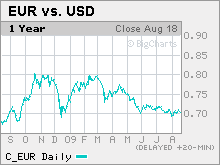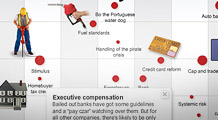Dollar slips on manufacturing, stocks
Global stock gains and positive manufacturing data chip away at safe-haven demand.
NEW YORK (Reuters) -- The dollar and yen edged lower Thursday in thin trade as gains in global stock markets and upbeat U.S. regional manufacturing data eroded safe-haven demand for the two currencies.
A report showed manufacturing in the Mid-Atlantic region expanded in August for the first time in 10 months, boosting optimism about a recovery. A rebound in China's stock market, which had fallen 20% over the last two weeks, also lifted spirits.
In recent months, the dollar and yen have tended to fall when markets grow more optimistic and as investors buy higher-yielding and riskier assets and currencies.
"The risk trade -- risk on, risk off -- is still the primary driver of the U.S. dollar," said Sacha Tihanyi, currency strategist at Scotia Capital in Toronto.
"It was nice to see (the Philly Fed index) move back into expansionary territory. Improved economic data will likely imply a weaker dollar for a little bit of time yet to come," he added.
U.S. and European stocks rose, following a 4.5% surge in the Shanghai Composite Index, which shed about the same amount the previous day.
In late New York trading, the euro rose 0.2% to $1.4263, near a one-week high of $1.4276 hit earlier in the session.
The dollar was 0.1% higher at ¥94.15 after hovering in a tight ¥93.83 to ¥94.55 range.
Major currencies traded in tight ranges and some analysts said the link between the dollar and risk appetite has started to weaken and that investors appear unwilling to extend already large positions against the U.S. currency.
"Some reluctance to sell the dollar on good U.S. data maybe partly reflects a market that was short the dollar from yesterday, and partly related to a summer lull," said Alan Ruskin, chief international strategist at RBS Securities in Greenwich, Conn.
"Either way it tells a tale of dollar shorts and risk positive trades that look tired." A short position is a bet that prices will fall.
A surprise expansion in regional manufacturing offset separate data showing an increase in the number of workers filing first-time jobless claims last week.
"We'll have a recovery but it is going to take a while to gain traction," said Meg Browne, senior currency strategist at Brown Brothers Harriman in New York. "U.S. interest rates will stay low for a while yet, and so now you're seeing a lot of positioning because there is not a lot to trade on."
The ICE Futures U.S. dollar index, which tracks the greenback versus a basket of currencies, was down 0.1%.
The pound was down 0.1% at $1.6513 after weak data on British public finances underscored concern about the country's fiscal situation.
One of the bigger movers was the Canadian dollar, which rose to its highest in about a week after Goldman Sachs (GS, Fortune 500) recommended buying the currency against the U.S. dollar.
The firm said U.S. fundamentals "will not improve sufficiently this year," and "genuine and broad dollar strength will 'not yet' materialize. The Canadian dollar looks "particularly attractive given its strong exposure to oil," Goldman wrote in a research note.
In other trading, the Norwegian crown hit its highest against the euro since March after data showed Norway's non-oil economy grew 0.3% from April to June. ![]()



